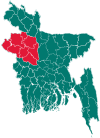Santhia
সাঁথিয়া | |
|---|---|
 Nagdemra Jame Masjid | |
 | |
| Coordinates: 24°3.5′N 89°32′E / 24.0583°N 89.533°E | |
| Country | |
| Division | Rajshahi |
| District | Pabna |
| Area | |
| • Total | 331.55 km2 (128.01 sq mi) |
| Population (2011) | |
| • Total | 380,301 |
| • Density | 1,100/km2 (3,000/sq mi) |
| Time zone | UTC+6 (BST) |
| Website | Official Map of Santhia |
Santhia (Bengali: সাঁথিয়া) is an upazila of Pabna District in the Division of Rajshahi, Bangladesh.[1]
Geography
[edit]Santhia is located at 24°03′30″N 89°32′00″E / 24.0583°N 89.5333°E. It has 89,032 households and a total area of 331.55 km2. Santhia has some forest-like areas with wild animals like foxes, mongooses, wild cats, etc. But these woods and animals are on the verge of extinction because of hunting and slash-and-burn.
Demographics
[edit]According to the 2011 Bangladesh census, Santhia Upazila had 89,032 households and a population of 380,301. 88,808 (23.35%) were under 10 years of age. Santhia had a literacy rate (age 7 and over) of 43.88%, compared to the national average of 51.8%, and a sex ratio of 989 females per 1000 males. 38,704 (10.18%) lived in urban areas.[2][3]
As of the 1991 Bangladesh census, Santhia has a population of 283,463. Males constitute 52.2% of the population, and females 47.8%. This Upazila's eighteen up population is 135,476.[4]
Administration
[edit]Santhia Upazila is divided into Santhia Municipality and ten union parishads: Ataikola, Bhulbaria, Dhopadaha, Dhulauri, Gourigram, Karanja, Kashinathpur, Khatupara, Nagdemra, and Nandanpur. The union parishads are subdivided into 176 mauzas and 234 villages.[2]
Santhia Municipality is subdivided into 9 wards and 27 mahallas.[2]
Chairman: 01. Abdullah Al Mahmud Deloar
Vice Chairman: 01.Md Khokon
Woman Vice Chairman: 01. Selima Rahman Shila
Upazila Nirbahi Officer (UNO): Md. Abdur Razzaque Sarker [1] Dr. Md. Aminul Islam Nasim, Physician
Municipality:
Chairman: Mahbubul Alam Bacchu
Councillors: Md. Abdul Awoal Md. Saiful Alam Md. Shirajul Islam Md. Daud
See also
[edit]References
[edit]- ^ Prabir Goswami Babu (2012). "Santhia Upazila". In Sirajul Islam and Ahmed A. Jamal (ed.). Banglapedia: National Encyclopedia of Bangladesh (Second ed.). Asiatic Society of Bangladesh.
- ^ a b c d "Bangladesh Population and Housing Census 2011 Zila Report – Pabna" (PDF). bbs.gov.bd. Bangladesh Bureau of Statistics.
- ^ "Community Tables: Pabna district" (PDF). bbs.gov.bd. Bangladesh Bureau of Statistics. 2011.
- ^ "Population Census Wing, BBS". Archived from the original on 2005-03-27. Retrieved November 10, 2014.

Well, that’s interesting to know that Psilotum nudum are known as whisk ferns. Psilotum nudum is the commoner species of the two. While the P. flaccidum is a rare species and is found in the tropical islands. Both the species are usually epiphytic in habit and grow upon tree ferns. These species may also be terrestrial and grow in humus or in the crevices of the rocks.
View the detailed Guide of Psilotum nudum: Detailed Study Of Psilotum Nudum (Whisk Fern), Classification, Anatomy, Reproduction